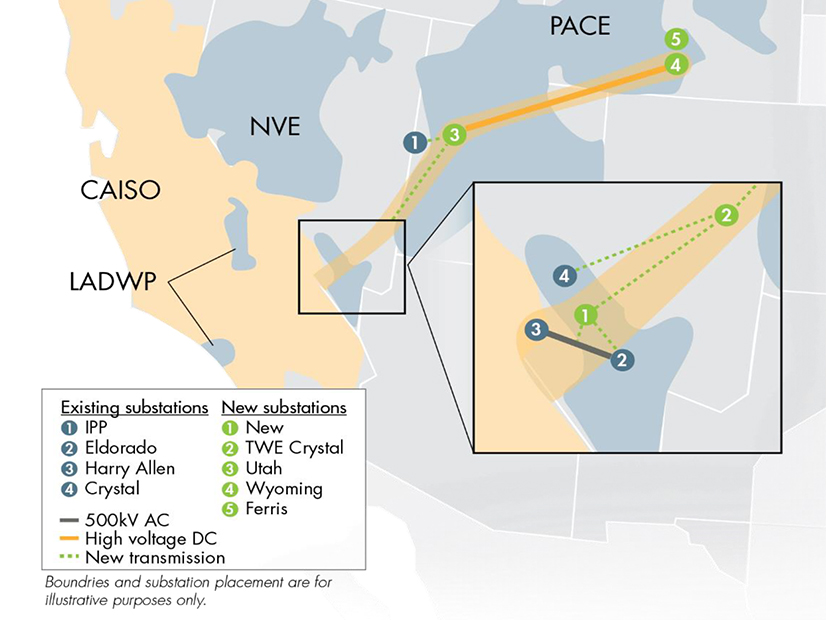
The CAISO Board of Governors voted Thursday to admit a merchant transmission project that plans to bring Wyoming wind to California as a participating transmission owner using a new subscriber model.
The admission of the TransWest Express is still “somewhat conditional,” requiring additional steps to complete, including signing up buyers in CAISO for the line’s wind energy, Neil Millar, vice president of infrastructure and operations planning, wrote in a memo to the board.
Assuming that happens, the project will expand CAISO’s reach hundreds of miles east and establish a new transmission-owner model, Deb Le Vine, CAISO director of infrastructure contracts and management, told the governors in Thursday’s board meeting.
“This is a unique opportunity that the ISO has to expand our grid and the way that participating transmission owners come into the ISO,” Le Vine said. “The uniqueness is that TransWest Express has already gone through a public solicitation and sold the rights to its transmission lines from Wyoming to California, and then they’ll be looking for off-takers for that wind generation — about 3,000 MW of wind that they’re looking at bringing in.”
Last year, TransWest conducted a FERC-approved open-solicitation process that offered firm, long-term transmission service to California via Utah and Nevada. It decided to allocate 100% of its capacity to Power Company of Wyoming, owner of a 3,000-MW wind farm being constructed in the south-central part of the state. FERC approved the arrangement in February.
Both TransWest and Power Company are wholly owned affiliates of The Anschutz Corp., a privately held company based in Denver and controlled by billionaire Phillip Anschutz, who made much of his fortune from fossil fuels and is now seeking to benefit from California’s clean energy mandate, which requires 100% of retail energy to be carbon-free by 2045.
To meet the 2045 goal, the state will need to import as much as 10 GW of out-of-state wind by 2040, at least half of it from Wyoming, according to projections by the California Public Utilities Commission and the California Energy Commission.
CAISO’s recent 20-year transmission outlook examined new transmission needed for the undertaking, predicting overall costs of $30 billion that includes $12 billion to carry wind from the Great Plains and Rocky Mountain states. (See CAISO Sees $30B Need for Tx Development.)
TransWest applied to join CAISO in July, saying in its application that it “intends to place under the CAISO’s operational control all of [its] project transmission lines and associated facilities … that will connect to the existing bulk power system in Wyoming and Utah as well as directly to the [CAISO]-controlled grid in Nevada.”
It would be CAISO’s first subscriber participating transmission owner (SPTO), a new model that would give the ISO control of power lines without increasing the ISO’s transmission access charge (TAC), currently more than $16/MWh. Some Western entities raised concerns about the SPTO model and asked that it be vetted in a stakeholder process, but CAISO chose to move ahead with the plan. (See TransWest Express Seeks to Join CAISO.)
Once built, TransWest will consist of 732 miles of transmission lines in three linked segments: a 405-mile, 3,000-MW HVDC system between Wyoming and Utah; a 278-mile, 1,500-MW HVAC line between Utah and Nevada; and a 49-mile, 1,500-MW HVAC transmission line in Nevada. It will connect in Utah to lines serving the Los Angeles Department of Water and Power (LADWP) and in Nevada to CAISO’s grid and balancing authority area.
The project is in an “advanced stage of development, focused on pre-construction matters including tower design and testing; interconnections; contracting with engineering, procurement and construction contractors; and financing,” the application said. “All major permits have been acquired, and 100% of the easements/authorizations to build on private lands have been secured.” Major parts of the project could be in service by 2026, it said.
Just before Thursday’s vote, TransWest Express COO Roxane Perruso thanked the ISO management team for “working with us on our application to become a participating transmission owner and the innovative subscriber PTO model. We think that this is a win-win for everyone … [that] avoids the need for a 39th balancing authority in the West and … particularly a generation-only BA.”


